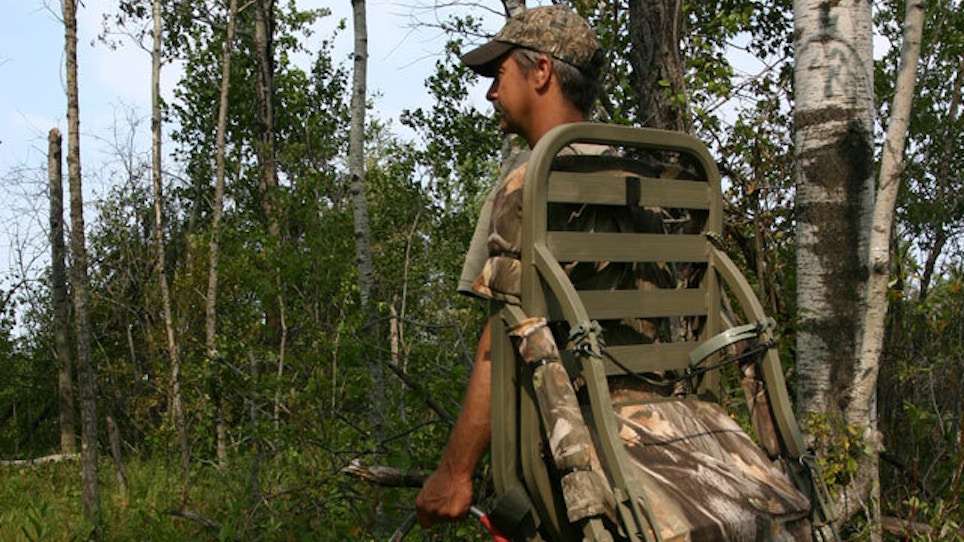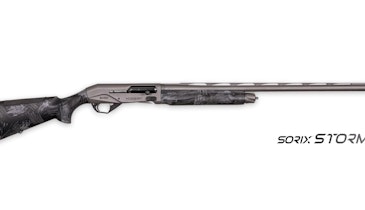As I shimmied up the two-by-four ladder and eased onto a makeshift platform positioned on the edge of a power-line swath that dissected an expansive tamarack swamp, there was no doubt in my mind it was going to be a long morning. During the night, the mercury had dipped to minus 20 degrees, and I tugged my toque down tight over my ears to deflect the brisk northwest wind as I settled in for the four-hour vigil. My traditional sit on the power line the second morning of the northern Minnesota whitetail opener evoked equal measures of dread and anticipation. It was a given I’d see deer. The power line was a veritable whitetail throughway — a corridor from the agricultural croplands where deer fed during the night to their bedding areas deep in the sprawling marsh. But sitting stoic for hours in the brutal cold took all the mental optimism and physical gumption I could muster. My fingers and toes were numb, and I was shivering uncontrollably when a doe and a 10-point buck appeared as ghosts on the far edge of the clearing two hours later and broke cover for the opposite side.
Hunters endure lengthy sits in all sorts of inclement weather because they know a well-planned ambush is the most effective means of getting sure-kill close to tight-wired, mature whitetails. Back in the day, most stands — ground blinds, elevated boxes and ladder stands — were permanent in nature, and most were constructed from scrap lumber. They were placed where deer traffic was heavy and encounters predictable. Most were erected along field edges, which gave the hunter the best visibility advantage. But too many were placed for convenience sake, with little thought given to how deer, especially mature bucks, used the property. Even those properly placed were fickle. If deer movement patterns were altered on the property due to changing food sources, bedding cover, water sources, etc., the investment in time and materials produced diminishing returns. The only recourse was to abandon them and build more stands.
While many hunters continue to erect and use permanent blinds for convenience and comfort, modern-day whitetail hunters have a host of options that give them more portability and creativity and the ability to make quick adjustments on the fly. These take the form of various factory-made semi-portable and portable treestands and pop-up ground binds. The hunter’s preferred style of hunting, the type and amount of property available and personal preference typically dictate the best choice or choices. But it does little good to wander through the woods haphazardly throwing up treestands or popping up ground blinds without giving serious consideration to how whitetails navigate that property and what the best locations are for intercepting them.
Location, Location, Location
Stand locations should be selected based on a host of environmental factors such as wind direction, food sources, water availability, bedding cover, etc. It seems obvious, but stands need to be placed where the likelihood of deer encounters is more probable than on any other place on the property. This requires having advanced knowledge of how deer use the land you hunt. This can be achieved by studying topo maps, using scouting cameras, glassing fields and good old fashioned leather-to-turf scouting. The better your recon, the better the probability you’ll place your stands where you have the best chance of killing a mature deer.
A good rule of thumb is to begin by making general observations of deer movement and then fine-tuning to selecting specific stand locations. First off, identify those topographical characteristics that funnel whitetails to particular spots on the property — feeding areas, bedding cover, proximity to water, travel corridors and such — looking for pinch points to place your stands. Ideally, most of your stands will be set up to take advantage of the prevailing wind, but it’s imperative to place additional stands for other wind conditions. Never hunt a stand if the wind is wrong, no matter how tempted you might be. Have a Plan B. Ideally you should set up downwind or crosswind of where you’ve determined deer will most likely approach. And don’t forget the sun. When possible, give yourself the Josey Wales edge by keeping the sun to your back, which, of course, will put the sun in a deer’s eyes should it look your way.
If you’re hunting over food plots, you have the options of intercepting deer on their way to feed or selecting ambush points as they come and go to the foot plot. Again, you should have several stands placed to cover various wind directions.
OK, we’ve set some of the ground work for where to place your stands. Now let’s look at the various stand options and how they might fit your style of hunting and the property you have available to hunt.
Hunting From High Places
Hunting from elevated stands is a proven tactic for getting sure-shot close to fidgety whitetails, whether you’re hunting with a rifle or bow. Without question, more whitetails are harvested each year from treestands than by any other method. The advantages are obvious: Hunting high gets you out of the line of sight of whitetails; it provides increased visibility by being able to see, and shoot, over lower brush clutter; you can get away with more movement; and scent isn’t as concentrated as it is at ground level. But it’s important to optimize the potential of each and every treestand you place, whether you’re hunting the back 40, or running and gunning on an expansive tract of public ground.
Many hunters will tell you to place your treestands as high as you can to optimize the stealth height will afford. But remember, the higher you climb, the more critical shot angle becomes and the higher the probability that you might catch only one lung on a broadside shot. Certainly don’t climb any higher than you’re comfortable with, because it could affect your ability to make a good shot. Look for a cluster of two or three large trees where you can tuck a stand in to help break up your outline. This will often mean you don’t have to climb as high. Use branches and foliage for concealment, but be sure to maintain clear shooting lanes. It does little good to conceal yourself so well that you can’t make the shot. Identify and trim obstructing branches so you have a clear path to any trail where you expect deer to approach.
Finally, carefully consider how you’re going to approach and depart your stand without spooking every deer in the area walking in and climbing into your stand. Some stands will be better for evening sits, such as field edges where you wait for deer to come to feed. Others are better in the morning, such as those placed to intercept deer coming off feed and heading to their bedding areas. Be sure that you are not crowding these areas and can come and go without alerting the deer you’re trying to hunt.
OK, now it’s time to select which style of elevated stand you’ll use. Your choices will greatly depend on your style of hunting, the property you’re hunting and your comfort level once your feet leave the ground. Treestands generally fall into three categories: hang-on stands, climbing stands and ladder stands, and each is designed to fit specific needs and situations. Be sure to consider hunting methods, portability, location, whether you’re hunting private or public land and a host of other factors before laying down the cash for your next treestand.
Hang-ons are arguably the most versatile of the portable treestands, suitable for most types of hunting. If you plan to hunt the same properties throughout the season, place as many as you can afford and leave them put, unless you have a good reason to move them. If you need to do any fine-tuning, hang-ons are reasonably portable and allow you to get in and out of an area without causing a lot of disturbance.
Hang several for different wind directions, and for morning and evening sits. They are also a good option for run-and-gun hunters. Many are portable and lightweight, and by using a handful of climbing pegs, you can get quietly into an area and set up an ambush.
Climbers are a great choice for public-land hunters, especially where it’s required to remove stands at the end of each day. They’re also great for the run-and-gunners who are hunting unfamiliar ground and scouting on the go. Their best attribute is that they’re very portable and you can get in and set up without causing much disturbance. The biggest limitation, as least where I hunt, is that large, straight, limbless trees can be tough to come by. Where this is not a problem — Deep South pine plantations, for example — they can be perfect for hunters on the go.
Ladder stands are the best option for hunters who want to hunt from an elevated stand but are uncomfortable with heights. While they are a little more difficult to erect and more suitable for semi-permanent situations, ladder stands are very stable and easy to get in and out of. You might have to get a buddy to help you put up your ladder stand, and you should try to have them in place several weeks before season so they have time to “settle in.” I consider these semi-permanent stands and generally leave them put for the season. They’re my first choice when rifle hunting on field edges or over food plots.
Staying Grounded
For hunters who have an aversion to heights or take pleasure in hunting at eye level, ground blinds are the ticket. Permanent box blinds work well on private land where whitetail movement is consistent and predictable, such as next to a food source, water supply or bedding cover. They become part of the environment, and deer typically don’t give them another thought. But like with other stands, use great care getting to and departing from them, so you don’t alert deer. If you do, you’ll see productivity take a swan dive.
But a better option, and one that adds versatility and maneuverability, is the use of a portable ground blind. These can be left for the entire season or used on the go. If you plan to leave them put the entire season, set them up well in advance of the hunt. If you’re running and gunning, conceal them with natural cover so they blend in with the surroundings. Whitetails notice anything that’s changed in their environment and will typically avoid any recently erected ground blind. They’re a great choice for public ground hunting if you don’t have to walk too far and have to bring your stand out with you each night. Pop-ups are reasonably portable and can be erected in a matter of seconds. Obviously, they are a good option where trees are scarce.
Another nice thing about ground blinds is that you can get away with more movement, which is good news for fidgety hunters or those who want to bring their young kids along. And they can serve double duty in the spring turkey woods or overlooking black bear baits so you can get more bang for your buck. Oh, and bowhunters: Practice shooting from a sitting position or on your knees if you choose to hunt from a ground blind.
Keeping It Real
Another option is to use nature’s bounty to lay an ambush. This could be as simple as tucking into a blow-down next to a well-traveled deer trail, sitting against a tree on an oak ridge overlooking a water source or climbing into the lower limbs of a tree next to a picked soybean field. This can be particularly effective if you’re on public ground or scouting property you’ve never hunted before, and will give you the mobility to hunt as you scout and move as you see fit. Think of it as still-hunting with short stalks and prolonged sits. One of my all-time favorite bow stands was the crotch of a huge oak tree in a finger of oaks that jutted out into the corner of a large corn field. Deer loved to cut through this cover, and if the wind was right — the only time I would hunt it — it was a deer magnet. Two climbing pegs would get me up into the tree where I was totally concealed just six feet off the ground.
Whether you prefer hunting from high places or laying a ground attack, the more thought you put into selecting those types of stands and locations that make the most sense for your style of hunting and the property you have available, the more likely you will find success in the whitetail woods.
Sidebar: Treestand Safety
No matter what type of treestand you’re hunting from, it’s imperative to stay connected from the second your feet leave the ground until you’re safely back on terra firma. Too many hunters climb up into their stands and then attach themselves to the safety harness, ignoring the well-known fact that most accidents occur climbing up into and out of stands — especially when taking that last critical step onto or off the platform. Watch the videos from Hunter Safety Systems at www.huntersafetysystem.com/instructions for the correct use of safety harnesses and climbing systems. Above all else, be safe!






